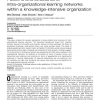Free Online Productivity Tools
i2Speak
i2Symbol
i2OCR
iTex2Img
iWeb2Print
iWeb2Shot
i2Type
iPdf2Split
iPdf2Merge
i2Bopomofo
i2Arabic
i2Style
i2Image
i2PDF
iLatex2Rtf
Sci2ools
JITECH
2010
2010
Patterns and structures of intra-organizational learning networks within a knowledge-intensive organization
This paper employs the network perspective to study patterns and structures of intraorganizational learning networks. The theoretical background draws from cognitive theories, theories of homophily and proximity, theories of social exchange, the theory of generalized exchange, small-worlds theory, and social process theory. The levels of analysis applied are actor, dyadic, triadic, and global. Confirmatory social network analysis (exponential random graph modeling) was employed for data analysis. Findings suggest: (1) central actors in the learning network are experienced and hold senior positions in the organizational hierarchy; (2) evidence of homophily (in terms of gender, tenure, and hierarchical level relations) and proximity (in terms of geographical and departmental distances) in learning relationships; (3) learning relationships are non-reciprocal; and (4) transitivity and high local clustering with sparse inter-cluster ties are significant for intra-organizational learning ne...
Exponential Random Graph | Intraorganizational Learning Networks | JITECH 2010 | Learning Networks |
| Added | 28 Jan 2011 |
| Updated | 28 Jan 2011 |
| Type | Journal |
| Year | 2010 |
| Where | JITECH |
| Authors | Miha Skerlavaj, Vlado Dimovski, Kevin C. Desouza |
Comments (0)

